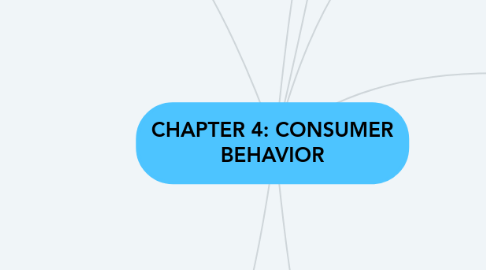CHAPTER 4: CONSUMER BEHAVIOR
af choy hui min

1. 4.2 Characteristics Affecting Consumer Behavior
1.1. Buyers
1.1.1. Personal
1.1.1.1. Personality and self-concept
1.1.1.2. Economic situation
1.1.1.3. Occupation
1.1.2. Social
1.1.2.1. Family
1.1.2.2. Reference groups
1.1.2.3. Roles and status
1.1.3. Psychological
1.1.3.1. Motivation
1.1.3.2. Perception
1.1.3.3. Learning
1.1.3.4. Beliefs and attitudes
1.1.4. Cultural
1.1.4.1. Subculture
1.1.4.2. Social class
2. 4.1 Model of Consumer Behavior -Marketing -Other stimuli -Buyer's black box- Buyer responses
3. 4.3 Types of Buying Decision Behavior
3.1. Complex Buying Behavior- In situations characterized by high consumer involvement in a purchase and significant perceived differences among brands.
3.2. Dissonance-Reducing Buying Behavior- Consumer buying behavior in situations characterized by high involvement but few perceived differences among brands.
3.3. Habitual Buying Behavior-Consumer buying behavior in situations characterized by low consumer involvement and few significant perceived brand differences.
3.4. Variety-Seeking Buying Behavior-Consumer buying behavior in situations characterized by low consumer involvement but significant perceived brand differences.
4. Consumer Buyer Behavior : The buying behavior of final consumers- individuals and households who buy goods and services for personal consumption.
5. Consumer market : All the individuals and households who buy or acquire goods and services for personal consumption.
6. 4.4 The Buyer Decision Process
6.1. 1. Need recognition
6.2. 2. Information search-personal sources, experiential sources, effective sources
6.3. 3. Evaluation of alternatives-use information to evaluate alternative brands in the choice set.
6.4. 4. Purchase decision- about which brand to purchase
6.5. 5. Post-purchase behavior-take further action after purchase, based on their satisfaction or dissatisfaction.
7. 4.5 The Buyer Decision Process for New Products
7.1. 1. Awareness
7.2. 2. Interest
7.3. 3. Evaluation
7.4. 4. Trial
7.5. 5. Adoption


